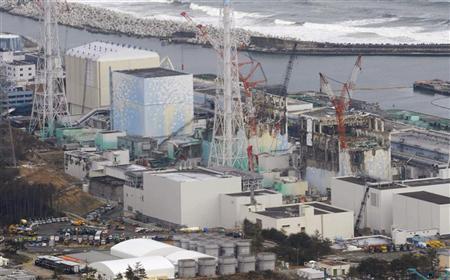Fukushima Radiation Higher Than First Estimated
Date: 25-May-12
Country: TOKYO
Author: Kevin Krolicki

Tokyo Electric Power Co. (TEPCO)'s tsunami-crippled Fukushima
Daiichi nuclear power plant's reactor buildings one to four (L to R)
are seen in Fukushima prefecture, in this aerial view photo taken by
Kyodo, March 11, 2012.
Photo: Kyodo
The radiation released in the first days of the Fukushima nuclear disaster was almost 2-1/2 times the amount first estimated by Japanese safety regulators, the operator of the crippled plant said in a report released on Thursday.
Tokyo Electric Power said its own analysis conducted over the past year put the amount of radiation released in the first three weeks of the accident at about one-sixth the radiation released during the 1986 Chernobyl disaster.
"If this information had been available at the time, we could have used it in planning evacuations," Tepco spokesman Junichi Matsumoto told a news conference.
Because radiation sensors closest to the plant were knocked out by the March 11, 2011 quake and the tsunami, the utility based its estimate on other monitoring posts and data collected by Japanese government agencies.
Tepco, set to be nationalized in July in exchange for a Japanese government bailout, estimated meltdowns at three Fukushima reactors released about 900,000 terabecquerels of radioactive substances into the air during March.
That was 2-1/2 times the amount of the first estimate by Japan's Nuclear and Industrial Safety Agency in April last year and about 17 percent more than the highest estimate provided by the government safety agency.
The estimate was based on measurements suggesting the amount of Iodine-131 released by the nuclear accident was three times higher than previous estimates, the utility said in the report.
Iodine-131 is a fast-decaying radioactive substance produced by fission that takes place inside a nuclear reactor. It has a half-life of eight days.
More than 99 percent of the radiation released by the accident came in the first three weeks, it added.
The Fukushima Daiichi plant, which had six reactors, was hit by a series of hydrogen explosions and meltdowns after power and cooling systems were cut off by the tsunami.
The World Health Organization released its own study this week concluding that residents around the Fukushima plant had been exposed to up to 20 times normal background radiation in the first year after the accident. That was still within the WHO's recommended emergency limit.
Officials expect it will take up to 30 years to decommission the Fukushima reactors. The accident has prompted a debate over the future of nuclear power in the resource-poor nation.
![]()
© Thomson Reuters 2012 All rights reserved